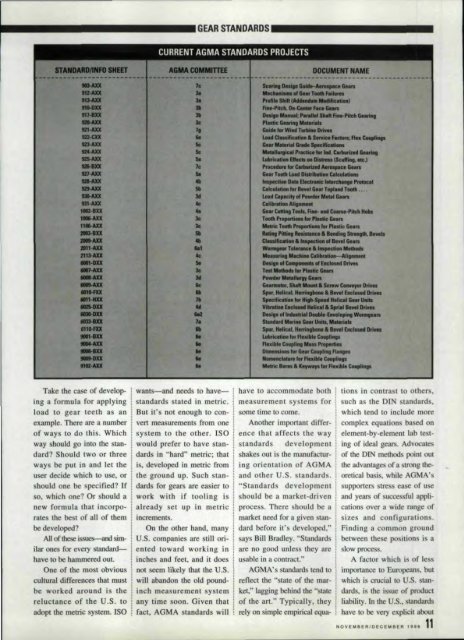Download the November/December 1996 Issue in PDF format
Download the November/December 1996 Issue in PDF format
Download the November/December 1996 Issue in PDF format
You also want an ePaper? Increase the reach of your titles
YUMPU automatically turns print PDFs into web optimized ePapers that Google loves.
_------------GEAR,STANDARDS----------<br />
.... ....<br />
--<br />
....<br />
-- .....<br />
--<br />
.....<br />
--- .....<br />
.....<br />
-.all<br />
• -111<br />
fW.AII<br />
--- .....<br />
-...<br />
..<br />
'II<br />
••..<br />
II<br />
II<br />
..<br />
II<br />
II<br />
'-<br />
II<br />
••III<br />
..<br />
41<br />
II<br />
II<br />
• •<br />
111<br />
..<br />
..<br />
III<br />
II<br />
•,.<br />
..<br />
III<br />
,.<br />
•II<br />
II<br />
II<br />
II<br />
II<br />
.................. .,,,.....<br />
• .. t , ..... TIIIII<br />
.......-"'.1 0<br />
DOCUMENT NAME<br />
.......<br />
., Mud",<br />
o..c- ..................................<br />
......... n.tIaa ......<br />
'-In .......<br />
.......................<br />
• • IIIIL c:.t.rt.I ......<br />
L*IMIIIII __ ..,<br />
.......... c.t.rIIM ....<br />
... T... LIM C III••<br />
.................... lh •• ,.PNIIeII<br />
c.InI..... ,., T T .<br />
...... c.,.cIIy ....<br />
C.II' .......<br />
... T fIIIe. c:-.-rtIcII .....<br />
T "........ a-n<br />
.... T... ".,.... ....<br />
............ d.a ......<br />
n•• IIIIII --. ......T--. .......<br />
....... c AI .<br />
....... C ~an-<br />
T ....<br />
,....<br />
............ _ c...,...an-<br />
..... IIIIiaJl "' be...., IIrMa<br />
............................. 1IafIJ<br />
......&oIIIM ......<br />
I~ ........<br />
............................<br />
................ , bI:IeJM anlIIIrIaIIeI<br />
........<br />
FIIdIIII c...-.. "..,.....<br />
Dr •• 11 c.,u.. .......<br />
11 " ........<br />
........ r.,-p c:..,IiIiI<br />
Take<strong>the</strong> case of develop<strong>in</strong>g<br />
a formula for a.pp~y<strong>in</strong>g<br />
load to gear teeth as an<br />
example. There are a number<br />
of way to do th:is. Which<br />
w.ay heuldgo <strong>in</strong>to tlte standard?<br />
Should two or three<br />
ways be put <strong>in</strong> and let <strong>the</strong><br />
user decide which to use, or<br />
hould one be specified? Wf<br />
0, which one? Or shootd a<br />
new formula [hat <strong>in</strong>corporate<br />
<strong>the</strong> be t of all of <strong>the</strong>m<br />
be developed?<br />
All, <strong>the</strong>se issues-and similar<br />
ones for every standardhave<br />
to be hammered out<br />
One of <strong>the</strong> most obviou<br />
wants--and<br />
needs to have--<br />
standards stated <strong>in</strong> metric.<br />
But it's nnt enough to COIIvert.<br />
measurements from one<br />
system to <strong>the</strong> o<strong>the</strong>r. ISO<br />
would prefer to have standards<br />
<strong>in</strong> "hard" metric; that<br />
is, developed <strong>in</strong> metric from<br />
<strong>the</strong> ground up. Such standards<br />
for gears are easier to<br />
work wilh if IlooiWng is<br />
already set up <strong>in</strong> metric<br />
mcrements.<br />
On '<strong>the</strong> o<strong>the</strong>r hand,. many<br />
U.S. companies are still Of1-<br />
ented toward work<strong>in</strong>g <strong>in</strong><br />
<strong>in</strong>cites and feet, and it does<br />
not seem likely that <strong>the</strong> U.S.<br />
culmral difference that must willabandon <strong>the</strong> old poundbe<br />
worked around i <strong>the</strong> <strong>in</strong>ch measurement system<br />
reluctance of <strong>the</strong> U.S. to any time soon. Given that<br />
adopt <strong>the</strong> metric ystem. wso 1 fact, AGMA standllJ'ds w<strong>in</strong><br />
have to accammodare both<br />
measurement systems for<br />
some time to come.<br />
Anollter important difference<br />
that affects <strong>the</strong> way<br />
standards development<br />
shakes out. is Lile manufactur<strong>in</strong>g<br />
orrentation of AGMA<br />
and o<strong>the</strong>r U.S. standards.<br />
"Standards development<br />
should be a market-driven<br />
process. There should be a<br />
market need for a given. tanda:rd<br />
before it's developed,"<br />
says Bill Bradley. "Standards<br />
are no good unless <strong>the</strong>y are<br />
usable <strong>in</strong> aeontract."<br />
AGMA' tandards tend to<br />
reflect <strong>the</strong> "state of '<strong>the</strong> market,"<br />
lagg<strong>in</strong>g beh<strong>in</strong>d <strong>the</strong> "Slate<br />
of <strong>the</strong> art" Typically. <strong>the</strong>y<br />
rel.y on. simple empirical equarlons<strong>in</strong><br />
contrast to o<strong>the</strong>r •<br />
such as <strong>the</strong> DIN standard,<br />
which tend to <strong>in</strong>clude more<br />
complex equation based on<br />
element-by-elementlab test<strong>in</strong>g<br />
of ideal gears. Advocates<br />
of <strong>the</strong> DIN methods po<strong>in</strong>t out<br />
fhe advantages of ,(1 !tOng <strong>the</strong>metical<br />
basis, while AGMA's<br />
supporters, stres s ease of II e<br />
and years of ueeessful applications<br />
over a wide range of<br />
izes and configurations.<br />
F<strong>in</strong>d<strong>in</strong>g a common ground<br />
between <strong>the</strong> e 'Positions is 8.<br />
slow process.<br />
A factor which is of less<br />
importance 1.0 Europeans. but<br />
which i crucial to U.S. tandams.<br />
i <strong>the</strong> issue of product<br />
liability. In th U.S.• standwds<br />
have 10 be very explici! ahaul<br />
NOVEUBEFlIOECEUB'ER 1111 11

















